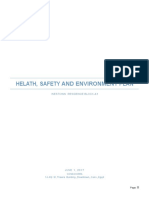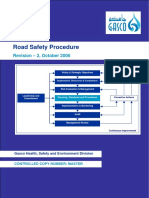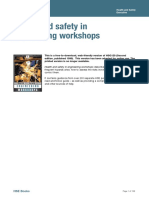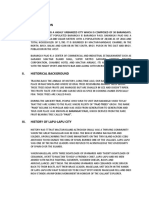Health-Safety-Risk-Assessment - A2
Health-Safety-Risk-Assessment - A2
Uploaded by
api-462916026Copyright:
Available Formats
Health-Safety-Risk-Assessment - A2
Health-Safety-Risk-Assessment - A2
Uploaded by
api-462916026Original Title
Copyright
Available Formats
Share this document
Did you find this document useful?
Is this content inappropriate?
Copyright:
Available Formats
Health-Safety-Risk-Assessment - A2
Health-Safety-Risk-Assessment - A2
Uploaded by
api-462916026Copyright:
Available Formats
Risk assessment template
Use this template to document a risk assessment to manage health and safety hazards and risks.
For more details on the risk management process refer to the Managing Health and Safety Risks factsheet.
Note: for risk assessments with curriculum activities refer to the Managing Risks in School Curriculum
Activities procedure.
Activity description: Murray Upper State School STEM event
Conducted by: Peri Baynton Date: 18/06/19
Step 1: Identify the hazards
Biological (e.g. hygiene, disease, infection)
Blood/bodily fluid Virus/disease Food handling
Other/details: Light refreshments available, ensure they are refrigerated and stored correctly to avoid contamination
Chemicals (note: refer to the label and safety data sheet (SDS) for the classification and management of all chemicals)
Non-hazardous chemical(s) Hazardous chemical (refer to a completed hazardous chemical risk assessment)
Name of chemical(s)/details:
Critical incident – resulting in:
Lockdown Evacuation Disruption
Other/details:
Energy systems – incident/issues involving:
Electricity (incl. mains and solar) LPG gas Gas/pressurised containers
Other/details: Activity involves using water, ensure this is conducted away from energy sources
Environment
Sun exposure Water (creek, river, beach, dam) Sound/noise
Animals/insects Storms/weather Temperature (heat, cold)
Other/details: In a confined area will require ventilation
Facilities/built environment
Buildings and fixtures Driveway/paths Workshops/work rooms
Playground equipment Furniture Swimming pool
Others/details: Arrange furnishing so they do not become a trip hazard
Machinery, plant and equipment
Machinery (fixed plant) Machinery (portable) Hand tools Vehicles/trailers
Other/details:
Manual tasks/ergonomics
Manual tasks (repetitive, heavy) Working at heights Restricted space
Other/details:
People
Reviewed May 2018 V2 Department of Education
Uncontrolled when printed. Organisational Safety and Wellbeing
Uncontrolled when printed
Students Staff Parents/others
Physical Psychological/stress
Other/details: guests invited
Other hazards/details:
Minor injury may be caused by Legos, as guest are invited younger siblings and children may choke on lego pieces
Step 2: Assess the level of risk
Consider the hazards identified in Step One and use the risk assessment matrix below as a guide to
assess the risk level.
DoE Risk Management Matrix
Consequence
Likelihood
Insignificant Minor Moderate Major Critical
Almost certain Medium Medium High Extreme Extreme
Likely Low Medium High High Extreme
Possible Low Medium Medium High High
Unlikely Low Low Medium Medium High
Rare Low Low Low Low Medium
Consequence Description of consequence Likelihood Description of likelihood
Will only occur in exceptional
1. Insignificant No treatment required. 1. Rare
circumstances.
Minor injury requiring first aid treatment Not likely to occur within the foreseeable
2. Minor 2. Unlikely
(e.g. minor cuts, bruises, bumps). future, or within the project lifecycle.
Injury requiring medical treatment or lost May occur within the foreseeable future,
3. Moderate 3. Possible
time. or within the project lifecycle.
Serious injury (injuries) requiring specialist Likely to occur within the foreseeable
4. Major 4. Likely
medical treatment or hospitalisation. future, or within the project lifecycle.
Almost certain to occur within the
Loss of life, permanent disability or multiple
5. Critical 5. Almost certain foreseeable future or within the project
serious injuries.
lifecycle.
Assessed risk level Description of risk level Actions
Low
If an incident were to occur, there would be little
likelihood that an injury would result.
Undertake the activity with the existing
controls in place.
Medium
If an incident were to occur, there would be some
chance that an injury requiring first aid would result.
Additional controls may be needed.
High
If an incident were to occur, it would be likely that an
injury requiring medical treatment would result.
Controls will need to be in place before the
activity is undertaken.
Extreme
If an incident were to occur, it would be likely that a
Consider alternatives to doing the activity.
Significant control measures will need to be
permanent, debilitating injury or death would result.
implemented to ensure safety.
Step 3: Control the risk
In the table below:
Reviewed May 2018 V2 Department of Education
Uncontrolled when printed. Organisational Safety and Wellbeing
Uncontrolled when printed
1. List the hazards/risks you identified in Step One.
2. Rate their risk level (refer to information contained in Step two to assist with this)
3. Detail the control measures you will implement to eliminate or minimise the risk.
Note: control measures should be implemented in accordance with the preferred hierarchy of
control. If lower level controls (such as administration or PPE) are to be implemented without
higher level controls, it is important the reasons are explained.
Hierarchy of controls
Most effective Elimination: remove the hazard completely from the workplace or activity.
(High level)
Substitution: replace a hazard with a less dangerous one.
Redesign: changing a machine or work process to make it safer.
Isolation: separate people from the source of the hazard.
Administration: putting rules, signage or training in place to make a workplace safer.
Least effective Personal protective equipment (PPE): protective clothing and equipment.
(Low level)
Hazards/risks and control measures
1. Description of 2. Risk level 3. Control measures (Note: if only administration or PPE controls are
hazards/risks used, please explain why)
Food handling and storage Medium Refrigerate foods and ensure safe food handling procedures are followed
Food contamination
Water Medium Only small amounts of water will be used so it is unlikely. Use water well
away from energy sources
Electrocution
Noise and temperature Low Air conditioners and fans, display noise level posters
Uncomfortable
Furniture and equipment Low Furnishing and equipment will be arranged to avoid trip hazards
Trip hazard
Guest High Guest with young children may attend. Lego is a choke hazard. Inform
parents of the risk in the permission form. Display warning signs
Other details:
Guest are reminded that young children will require parent supervision
Submission
This activity will be conducted in accordance with this risk assessment, implementing the control measures outlined in Step
Three. Changes will be made to the activity, if required, to manage any emerging risks to ensure safety.
Contact person: Peri Baynton Date: 12/06/19
Reviewed May 2018 V2 Department of Education
Uncontrolled when printed. Organisational Safety and Wellbeing
Uncontrolled when printed
Indicate those others involved in the preparation of this risk assessment:
Principal
Teacher’s aide
Step 4: Monitor and review controls
Complete during and/or after the activity Yes No
1. Are the planned control measures sufficient and effective in minimising the level or risk?
2. Have there been any charges to the planned control measures?
3. Are further control measures required in future?
Details:
Review completed by: Designation:
Signature: Date:
Modified for assessment Purpose. (Queensland Government, Department of Education. (2019). Education. Retrieved
from https://education.qld.gov.au/sitesearch/Pages/results.aspx?k=risk%20assessment).
Reviewed May 2018 V2 Department of Education
Uncontrolled when printed. Organisational Safety and Wellbeing
Uncontrolled when printed
You might also like
- HSE AwarenessDocument70 pagesHSE Awarenessعبدالحميد عبدالغفار الدرديري67% (3)
- IoshDocument52 pagesIoshmohamed ghazyNo ratings yet
- Hazard Identification and Risk AssessmentDocument4 pagesHazard Identification and Risk AssessmentEldhose Varghese100% (2)
- SHEQXel Performance Monitoring ToolDocument108 pagesSHEQXel Performance Monitoring ToolAmine Rachid100% (1)
- IOSH Managing Safely Training SyllabusDocument1 pageIOSH Managing Safely Training SyllabusIrfan AhmedNo ratings yet
- Warwick District Council Corporate Health & SafetyDocument18 pagesWarwick District Council Corporate Health & SafetySarah WalkerNo ratings yet
- NCP For Disturbed Sleep Pattern and Impaired ComfortDocument7 pagesNCP For Disturbed Sleep Pattern and Impaired ComfortMaila Joy Pring Fuentes50% (2)
- Budget of Work In-Nail Care - 7Document8 pagesBudget of Work In-Nail Care - 7JuvyGonzales100% (4)
- IOSH Project 34/38 MarksDocument7 pagesIOSH Project 34/38 MarksSaleem Shahzad KhanNo ratings yet
- HSEkpisDocument14 pagesHSEkpissam lissenNo ratings yet
- CONST-PK-HSE FRM-38 Environmental Risk Assessment and Control FormDocument6 pagesCONST-PK-HSE FRM-38 Environmental Risk Assessment and Control FormPerwez21No ratings yet
- Safety DetailsDocument3 pagesSafety DetailsNauman TajNo ratings yet
- Oil India Limited: Onshore Emergency Response PlanDocument23 pagesOil India Limited: Onshore Emergency Response Planaji sathyanandanNo ratings yet
- Vibration Risk Assessment: (Site/ Building/ Room)Document3 pagesVibration Risk Assessment: (Site/ Building/ Room)Him SiwakotiNo ratings yet
- Hazard Identification and Risk Assessment: Your Company Logo HereDocument6 pagesHazard Identification and Risk Assessment: Your Company Logo HerepaulNo ratings yet
- A002 C NightclubDocument6 pagesA002 C NightclubBlas de LezoNo ratings yet
- HSE CONTRACTORS' MEETING - MEETING PPT - February 2019Document53 pagesHSE CONTRACTORS' MEETING - MEETING PPT - February 2019JosiahNo ratings yet
- Job Safety Analysis For SupervisorDocument35 pagesJob Safety Analysis For SupervisorSayeed MalikNo ratings yet
- Working Environmental HazardsDocument5 pagesWorking Environmental HazardsSri100% (1)
- Nebosh HSWDocument6 pagesNebosh HSWMohammad AshrafNo ratings yet
- Chemicals Can: Safe Handling of ChemicalsDocument1 pageChemicals Can: Safe Handling of ChemicalsJavier Quintero SaavedraNo ratings yet
- RRC Risk Assessment Dec 2010Document14 pagesRRC Risk Assessment Dec 2010Li ChenNo ratings yet
- HSE HAVS PresentationDocument34 pagesHSE HAVS PresentationnicholasNo ratings yet
- NEBOSH HSE Certificate in Process Safety Management PDFDocument1 pageNEBOSH HSE Certificate in Process Safety Management PDFVasanth KathiranNo ratings yet
- JSA 06 (Rebar Assembly Work)Document8 pagesJSA 06 (Rebar Assembly Work)abdulthahseen007100% (1)
- HSE Perfomance Report Jan-21Document2 pagesHSE Perfomance Report Jan-21Bassam HSENo ratings yet
- HSE 201 Safety Managment & Engineering - EbookDocument88 pagesHSE 201 Safety Managment & Engineering - EbookNitish RajNo ratings yet
- Critical Controls Booklet - Drafts - V2 - HighDocument26 pagesCritical Controls Booklet - Drafts - V2 - HighXiufu WuNo ratings yet
- Risk Assessment TEMPLATEDocument2 pagesRisk Assessment TEMPLATElwillia16No ratings yet
- RA of Front Hand LoaderDocument6 pagesRA of Front Hand LoaderkoketsoNo ratings yet
- Emergency Response Plan: (For Makori Early Production Facility Project)Document13 pagesEmergency Response Plan: (For Makori Early Production Facility Project)waqarahmedogarNo ratings yet
- 1a. HSE FundamentalsDocument51 pages1a. HSE FundamentalsEllder Preye EkiyeNo ratings yet
- HSE Planner Sharjah Office 2023Document1 pageHSE Planner Sharjah Office 2023Badr AlmaazmiNo ratings yet
- Reporting FormatDocument1 pageReporting FormatknuraliyevNo ratings yet
- Risk Assessment - Site EstablishmentDocument9 pagesRisk Assessment - Site EstablishmentdebruynbeerNo ratings yet
- Road HaulageDocument3 pagesRoad HaulageNorman Ainomugisha100% (1)
- 2013 HSE Annual Report Web FINALDocument74 pages2013 HSE Annual Report Web FINALThiếu Nhiều Thứ100% (1)
- Health: Hygiene Sanitation ExposureDocument3 pagesHealth: Hygiene Sanitation ExposureWaqarAhmedButtNo ratings yet
- Baseline Risk Assessment: Phindile Kula (Project Coordinator)Document9 pagesBaseline Risk Assessment: Phindile Kula (Project Coordinator)EmilNo ratings yet
- HSE Induction For Visitors To PDODocument5 pagesHSE Induction For Visitors To PDOmartins73No ratings yet
- Safety AlertDocument1 pageSafety Alertjithin shankar100% (1)
- Risk Assessment For Collaborative OperationDocument23 pagesRisk Assessment For Collaborative OperationTata OdoyNo ratings yet
- Annexure C HSE QuestionaireDocument8 pagesAnnexure C HSE QuestionaireDie HArdNo ratings yet
- SODIC - Safety Plan v.01Document64 pagesSODIC - Safety Plan v.01مصطفىمحمدNo ratings yet
- GASCO Road Safety ProcedureDocument26 pagesGASCO Road Safety ProcedureRawan Alwan ZarifNo ratings yet
- Safety and Accident Loss Statistics: Prof. Shishir SinhaDocument43 pagesSafety and Accident Loss Statistics: Prof. Shishir SinhaganeshNo ratings yet
- FiveSteps PDFDocument1 pageFiveSteps PDFMohamed FouadNo ratings yet
- BBS SafetyDocument34 pagesBBS SafetyAbhaySnghNo ratings yet
- IOSH Risk AssessmentDocument18 pagesIOSH Risk AssessmentMichael Rene ParagasNo ratings yet
- Hazard Identification, Risk Assessment & Risk ControlDocument3 pagesHazard Identification, Risk Assessment & Risk ControlHafizzuddin Mohaidin100% (1)
- Hse Report Pls130116 Mar 2015Document15 pagesHse Report Pls130116 Mar 2015fatimah beluhiNo ratings yet
- Chapter 3: Management Control and RiskDocument3 pagesChapter 3: Management Control and Riskannastasia luyahNo ratings yet
- hsg129 PDFDocument138 pageshsg129 PDFmanimeczNo ratings yet
- JIP 6 Oil Spill Risk AssessmentDocument152 pagesJIP 6 Oil Spill Risk AssessmentJefferson SoaresNo ratings yet
- Safety Campaign-Energy Isolation-April 2022Document7 pagesSafety Campaign-Energy Isolation-April 2022HSE99 BHDCNo ratings yet
- QHSE Annual Report PresentationDocument31 pagesQHSE Annual Report PresentationSAQIB UMARNo ratings yet
- PTW Check ListsDocument30 pagesPTW Check ListsRoshin99100% (1)
- EHS Handbook FINAL 2013-12-11Document8 pagesEHS Handbook FINAL 2013-12-11Erica LindseyNo ratings yet
- Health 1Document5 pagesHealth 1Birendra GCNo ratings yet
- Risk Assessment Template: Step 1: Identify The HazardsDocument4 pagesRisk Assessment Template: Step 1: Identify The HazardsMyolwinooNo ratings yet
- Field Trip Risk AssessmentDocument4 pagesField Trip Risk Assessmentapi-287142055100% (1)
- ReflectionDocument2 pagesReflectionapi-462916026No ratings yet
- FlyerDocument1 pageFlyerapi-462916026No ratings yet
- Student ResourceDocument2 pagesStudent Resourceapi-462916026No ratings yet
- Teacher ScheduleDocument2 pagesTeacher Scheduleapi-462916026No ratings yet
- 6 Budget 1Document2 pages6 Budget 1api-462916026No ratings yet
- Parentconsent StemDocument2 pagesParentconsent Stemapi-462916026No ratings yet
- Clostridium - Botulinum.Document26 pagesClostridium - Botulinum.tummalapalli venkateswara rao100% (1)
- Executive SummaryDocument14 pagesExecutive SummarySyed MubarakNo ratings yet
- Fundamental Principles of International Humanitarian LawDocument3 pagesFundamental Principles of International Humanitarian LawAyban NabatarNo ratings yet
- ADP 2023-24 Guidelines and Schedule TentativeDocument6 pagesADP 2023-24 Guidelines and Schedule TentativeShahzaib ShaikhNo ratings yet
- Lecture # 3, Separate Source & Induce TestDocument26 pagesLecture # 3, Separate Source & Induce Testraza239No ratings yet
- Bone AssignmentDocument21 pagesBone AssignmentTayaba Naim KhanNo ratings yet
- Toughness Index and Energy AbsorptionDocument8 pagesToughness Index and Energy AbsorptionvempadareddyNo ratings yet
- ACCT201 Review Sheet - Exam 2Document3 pagesACCT201 Review Sheet - Exam 2duekNo ratings yet
- ACIIDA - SP - 1 Direct Anterior ApproachDocument30 pagesACIIDA - SP - 1 Direct Anterior ApproachJayjeet BhoiteNo ratings yet
- 5.3 Bond Enthalpies SlidesDocument60 pages5.3 Bond Enthalpies SlidesAGNINI-Bile DylanNo ratings yet
- The Umbrella ManDocument7 pagesThe Umbrella Manמקס שפנרNo ratings yet
- Broch Microbiological TestingDocument28 pagesBroch Microbiological TestingMudassir Ali QazalbashNo ratings yet
- Profile of Brgy Pajo, Lapu-Lapu City, CebuDocument10 pagesProfile of Brgy Pajo, Lapu-Lapu City, CebuNiel100% (2)
- Navi Mumbai IDocument14 pagesNavi Mumbai IPrathmesh R MulukNo ratings yet
- Problems in Fluid Mechanics - Baranyi PDFDocument130 pagesProblems in Fluid Mechanics - Baranyi PDFNasser ShelilNo ratings yet
- Capacitor ConnectionDocument4 pagesCapacitor ConnectionvellaicNo ratings yet
- C45 Medium Carbon Steel - Hillfoot Multi MetalsDocument1 pageC45 Medium Carbon Steel - Hillfoot Multi MetalsEnter ExitNo ratings yet
- Shark Shield User ManualDocument26 pagesShark Shield User ManualAhmed ArafatNo ratings yet
- Bedside Handover PDFDocument20 pagesBedside Handover PDFshutekiNo ratings yet
- Annex 6: Content and Format of Iee and Siee: Environment Assessment & ReviewDocument8 pagesAnnex 6: Content and Format of Iee and Siee: Environment Assessment & ReviewAlia KhanNo ratings yet
- An Autonomous Institute Affiliated To Savitribai Phule Pune UniversityDocument3 pagesAn Autonomous Institute Affiliated To Savitribai Phule Pune Universitycpt.ghostNo ratings yet
- Professional Communication Habbiche Hadjer 2206122Document6 pagesProfessional Communication Habbiche Hadjer 2206122Hadjer Ah BeyNo ratings yet
- BANKRUPTS CAN NOW APPLY FOR EARLY DISCHARGE (Research)Document7 pagesBANKRUPTS CAN NOW APPLY FOR EARLY DISCHARGE (Research)anistasnim25No ratings yet
- CLASS PROGRAM G11 LevelDocument5 pagesCLASS PROGRAM G11 LevelPetRe Biong PamaNo ratings yet
- Child Welfare Policy and Practice 11Document4 pagesChild Welfare Policy and Practice 11AdrianNo ratings yet
- Pure Epoxy Fx-E400: Technical Data SheetDocument7 pagesPure Epoxy Fx-E400: Technical Data SheetRana Ahmad Aamir100% (1)
- Miracles, Miracles, MiraclesDocument122 pagesMiracles, Miracles, MiraclesCharles and Frances Hunter100% (9)
- Naming Reaction FinalDocument9 pagesNaming Reaction FinalRajendra ThamerciNo ratings yet































































































